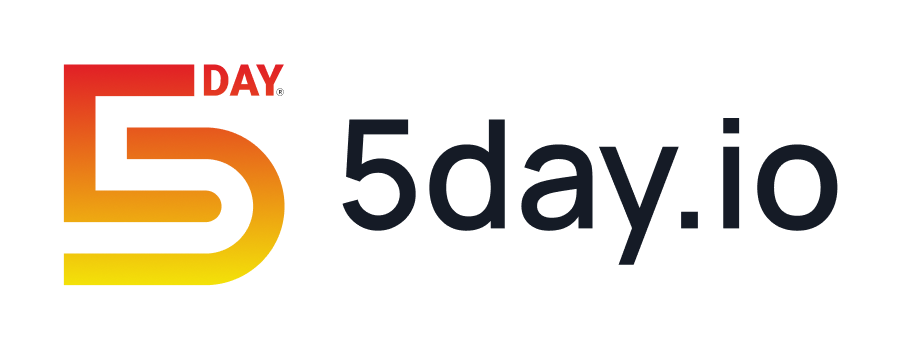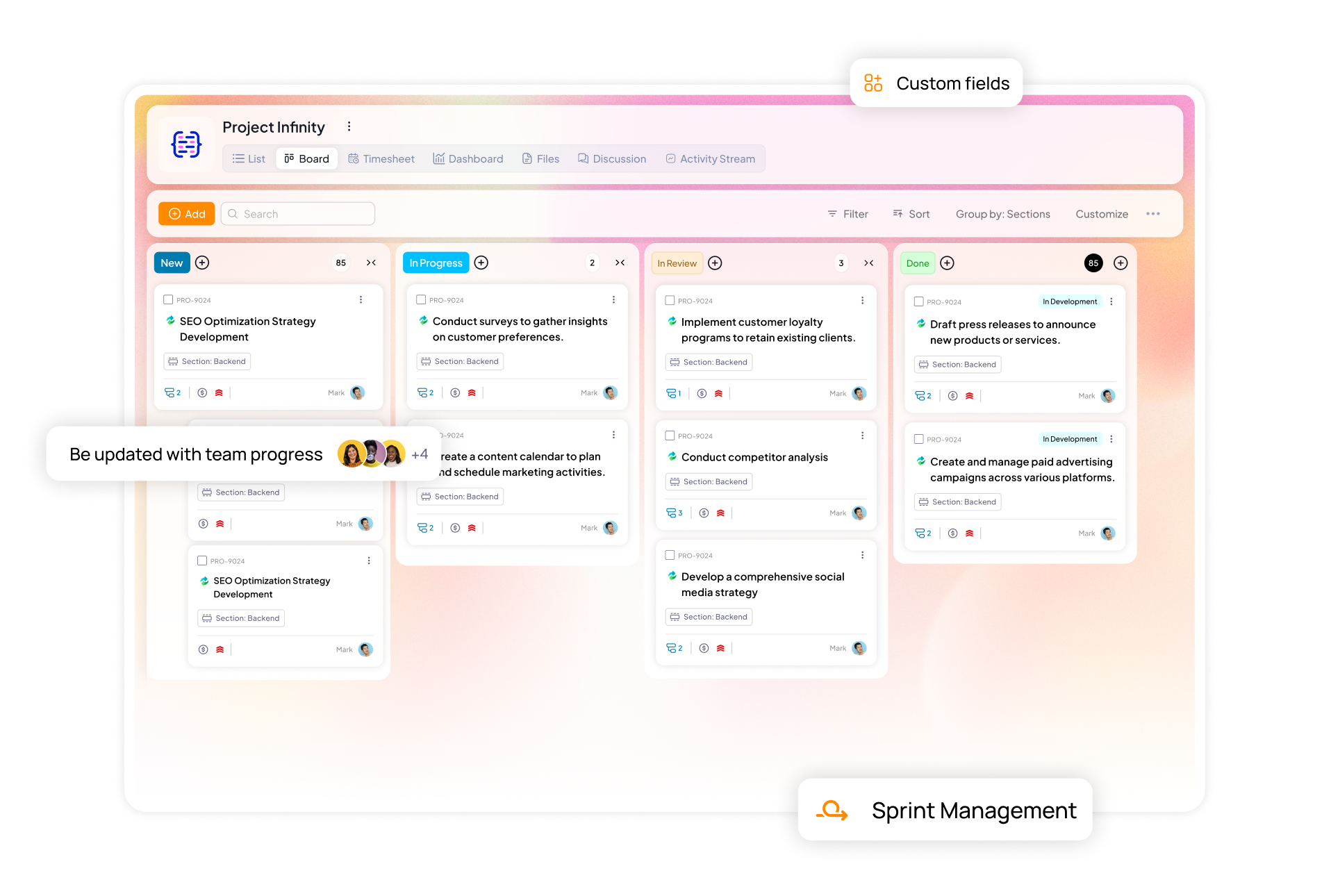Most generic project management tools weren’t built with marketers in mind. They miss the nuance, the approvals, assets, and the real-time feedback loops. They slow you down when you need to move fast.
That’s why specialized marketing project management software is a game-changer.
In this article, we’ll break down exactly what features matter most to marketing and agency teams, and how to choose the right tool.
Why marketing teams need specialized project management tools
Unlike product and engineering teams, creative teams don’t work in airtight stages. Once a task is completed, it’s impossible to lock it until the project itself is completed. Audience trends change, a client may have a change of heart that needs to reflect in the locked task, the creative director may have an Ahaa moment to capitalize on moment marketing – the list is endless.
Multiple back-and-forth changes and conversations happen on each task and sub-task. A generic tool won’t be able to handle this efficiently. Even if it did, it would require the team to create a deluge of tasks and sub-tasks which would result in a maze no one wants to dig through. This ultimately defeats the point of having a project management tool.
Campaigns are deadline-heavy
There are three types of deadlines for every task in an agency – one for internal review, one for client review, and one for going live. For special campaigns another deadline comes into play – the season itself, like Black Friday, Thanksgiving, Deepavali weekend etc. Multiple deadlines mean each one must be carefully followed in order to lead to timely delivery in each phase.
Project managers are already swamped tying people and processes together and can’t be looking at and comparing deadlines for every task. You need a system that automatically alerts your team of any missed deadline, so everyone knows where the project dependency lies.
Multi-level collaborations happen all the time on multiple tasks

Your content team receives blog briefs, a Whitepaper outline, case study requirements and a press release all in a few days. Each line item requires the team to work with different teams. For the blog, they’ll have to contact the product team to get relevant screenshots, and coordinate with design to make it aesthetic.
The Whitepaper will require extensive coordination and multiple dependencies with internal and external subject matter experts, and the design team. The case study mandates close coordination with the sales, customer success, product, onboarding, and client POCs. Each deliverable involves many people apart from the internal creative team.
A generic tool may have a collaboration system, but can it handle this volume? Not particularly.
Also Read: 10 Best Project Management Software in 2025
Need to measure success step-by-step
As exhilarating as working on creative tasks sounds, marketers are tied to results. Your team must prove engagement, traffic, leads, and conversions for every campaign, and ensure every task culminates in conversions for the brand. Generic tools make it way harder to integrate project to campaign tools. Every time you run a campaign, you must go back and forth between tools to see which task led to which prospects approaching your team.
A good project management tool allows you to sync with analytics platforms (like Google Analytics, HubSpot, or social media dashboards) to pull in real-time performance data. The PM also should be able to give you custom reports on task-level success and campaign level success, so you know who to attribute to which.
It also paves the way for root-cause analysis, and fixes any broken links or gaps, to make the next campaign more successful than your last one. Can a generic project management tool give you all this? Probably not.
Cookie-cutter templates that don’t serve your needs
For every requirement that comes in, be it a landing page design, a creative social post, your team is trained to work on a template that furnishes them with all the information they need. The context, intent, target audience, where it’ll be used, what’s the desired outcome, branding guidelines to follow, context-specific guidelines to follow, budget, timelines, and so much more. Generic project management tools have very broad templates and not ones that you can use on the go.
Marketing-specific project management tool, on the other hand, it does two things. One, it has task-level templates that don’t need much tweaking, and you can use them readily. Second, it also lets you create your own organization-wide templates with simple drag and drop actions.
No room for capacity planning or time tracking based on estimates
As a project manager, your job doesn’t end with allocating tasks. You’re also responsible for managing the current and future bandwidth of your team, and how they are likely to be utilized. Which creative is working on what type of task? How much of their bandwidth is consumed? How much capacity do they have this week/month? Do they have tasks that directly correspond to their skill set?
This problem happens most of the time with freelancers. One month you’re giving five creatives each to every designer, except one, since they were out of bandwidth. The next month, without proper capacity-related data, you’re still allotting the same numbers you were before, potentially overloading other freelancers in the team.
Getting these details manually through your 1:1s is doable, yes, but is it sustainable? No. Ideally, your project management tool needs to be able to give you this data.
Can generic tools do this? Most unlikely, and it’d take you big bucks to customize them with a developer’s help.
Must-have features in project management for marketers, and large marketing teams
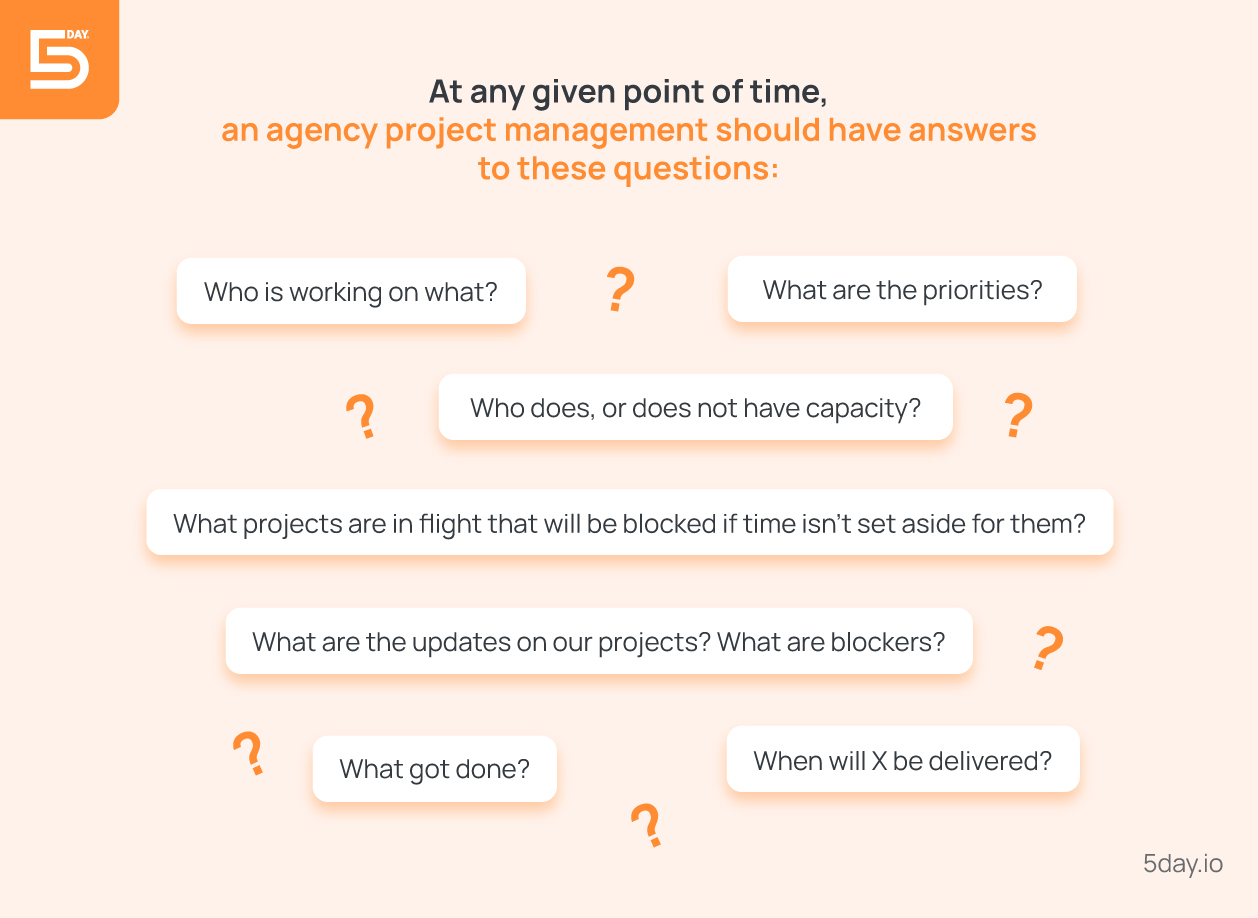
Now that we’re clear why generic tools don’t come close to serving your agency’s burning priorities, let’s talk shop. What exactly do you need to make your daily project management a breeze?
Crystal clear campaign planning & multi-level calendar view
A visual, drag-and-drop calendar view is essential. Marketers need to see the big picture immediately, know what’s going live and when, and ensure nothing clashes or slips through the cracks. Whether it’s coordinating blog posts, paid ads, social media content, newsletters, or webinar promotions, the ability to lay it all out like a living, breathing timeline saves the day.
With a strong calendar view, your team can sync campaigns across channels, email, social, events, product, and ensure they support one another instead of operating in silos. For example, your social content can be perfectly timed to amplify a new eBook launch, which in turn feeds your lead gen campaign.
And the best part? You’re not locked into one view. Zoom in to manage the nitty-gritty of this week’s tasks or zoom out to spot gaps or overlaps in your quarterly roadmap.
Creative asset management
You ask any project manager like you in any agency, and they will tell you how every creative is onboarded onto a project/task. “We send an email with all pertinent documents, links, PDF files, and images. We add them to the respective channel and brief them with project scope, and everything that has been going on”, they will say. This may look OK for a smaller agency, but for one with burgeoning clients and ones that are constantly onboarding new talent to meet project demands, this could bog down the process.
When every project needs asset collation and email sent, there’s a big chance some asset or an important conversation is being left out.
You, as a project manager, can’t go back to all important documents and conversations and compile them. Not amidst the mountain of work you’re already handling. A space that allows for all types of files and links (PDFs, Figma links, images, audio clips, you name it) for every project is a real lifesaver. When added to the project, anyone can see all past conversations, any recurring feedback the creative needs to take note of, past versions that weren’t fully accepted, guidelines to be followed etc.
Marketing-specific templates
You’ve already launched five product launches this year, and guess what? You’re about to do three more things. The playbook doesn’t change drastically. There’s always an email series, landing pages, paid ads, social creatives, internal checklists, UTM tracking, and probably five rounds of approvals somewhere in there.
This is where marketing-specific templates become a total game changer.
Instead of building every campaign process from scratch, teams can create or reuse pre-built workflows tailored to common marketing activities. Be it, product launches, lead gen campaigns, holiday promos, webinars, rebranding efforts, you name it, you can templatize it. These templates lay out the steps, assign roles, set realistic deadlines, and include reminders and checklists, so nothing slips through the cracks, even when things move fast.
What about larger teams with lots of moving parts (and lots of people)? Templates bring consistency to execution and make sure that a task is picked up by a senior strategist or a new hire, and everyone follows the same best-practice roadmap.
With the right templates creation and modification features in the project management software, your team can spend time on ideas, and not on approving structures.
Team collaboration features
Is your team’s work stalled by multi-level client approvals, and with zero accountability? That’s a blocker. You need an ownership matrix embedded into your project management system, so you know which tasks are dependent, linked, who must approve which work item, which stage, how much they have for the same, and who it gets passed on to for the next step.
When every step is configured into your system, and the next time someone asks, “What’s the status?” in your client’s WhatsApp group, you don’t have to DM every creative or ask “Pls update status folks” in your internal group. You’ll know exactly whom to tag, ask for update (internal or external), so there’s no blame game.
A collaborative project management tool for marketing teams can simplify this for you, with easily retrievable conversations, and threaded comments under every project and tag.
Teaming up with multiple teams for a task? Bring everyone in a project, or task, without letting them know other details about the project. Control who has access to what details within the project, while still collaborating easily.
Client approvals and feedback loops
Sean Tambagahan, founder of the Butler Branding Agency says, “For creative and marketing agencies, project success is determined by clients, which forces us to jump around from one task to the next, that prolongs deadlines and ensures that the ball will get dropped and worst of all, you’re going to find yourself doing majority of the work for half the price.”
No more chasing edits through scattered WhatsApp chats, digging through inboxes for the latest version, or guessing what “change the vibe” means. With a marketing project management software, stakeholders and clients can annotate directly on the creative, whether it’s a design, ad copy, video, or landing page. You can tag specific people for feedback. You can also clarify what’s being asked and assign due dates for reviews promptly.
Approvals are trackable, auditable, and time stamped. Everyone knows who gave the green light and when. No more “I never saw this” surprises down the line.
When feedback is looped back into the same system where tasks live, there’s no disconnect between revision and action. Your designer sees the comment, makes the tweak, marks it done, all in one place.
Task automation & recurring workflows
A huge part of marketing is experimentation, yes. But the other part is repetition—week after week, month after month. Most of it is done manually by marketing agencies. And it quietly eats up your team’s time and mental energy every single day.
Take the monthly ritual of following up with every paid ads expert working on different regional campaigns, getting them to pull performance reports, and then spending hours compiling it all into a single document the client can make sense of.
They still need to be created, assigned, followed up on, and delivered. That’s where project management automation steps in, not to do the marketing work for you, but to reduce the project overhead around it.
With the right software, you can set recurring task templates so that publishing and reporting tasks are auto-created each week or month. You can also pre-assign the right stakeholders, deadlines, and dependencies.
Additionally, you automatically notify team members the moment a task is generated, or its status changes. The right tool can help you build workflows that auto-update project status at set intervals, like “5 campaigns launched, 2 in progress” on the 30th of each month, so your team and clients have visibility without constant check-ins.
Also Read: The Best Task Management Software
Custom dashboards & reporting
Your agency’s leadership needs to have a bird’s eye view of every major task in every client project. More so for high-ticket ones. Similarly, depending on the project management methodology your agency follows, leaders may be hands-on with every project for a few weeks and then let the account managers handle it for the rest of the tenure.
If your operations head wants to take a look, they only need to know how many people are being utilized, if the project is moving, and if you need any additional support to get it done within the budget.
Depending on what level of visibility each stakeholder needs, you need to be able to allot access and customize the dashboard accordingly.
And then, there’s the account manager — the one in the trenches. They want to know who’s working on what, which deliverables are in review, what’s waiting on client feedback, and how far we are from go-live.
The best project management software lets each role curate their own lens into the work, agency leadership can see top-line metrics across accounts: timelines, burn rate, client feedback velocity, margins.
Project managers get granular, spotting stuck subtasks, overdue items, and blockers in real-time.
Budget & Resource management
Marketing projects, especially agency-led or cross-functional ones, can get expensive fast. You’re juggling freelancers, ad spend, tools, content production costs, and internal hours. And if you’re not actively tracking these against the project budget? That’s a sure shot recipe for disaster.
Great marketing project management tools let you track actual hours worked vs estimated, so you know if that client brief that “should take 10 hours” is now eating up 25. It also gives you access to see how people’s time is allocated across clients or campaigns, so no one is burning out quietly in the background.
If you can see, mid-sprint, that you’ve already hit 80% of your time and budget, you can raise the flag early. Have a conversation about scope. Re-prioritize. Pull in support. That kind of proactive insight is what keeps clients happy, teams balanced, and projects profitable.
Third-party integrations
You write content in Google Docs. Designs come in from Figma or Canva. Slack is buzzing nonstop. You track performance in Google Analytics or Meta Business Manager. Client feedback might show up in Loom, email, or a surprise WhatsApp message. If your project management tool doesn’t talk to other work tools you use, you end up doing double work, chasing files, copy-pasting updates, and stitching together conversations that should’ve just been there in the first place.
With the right integrations, your project management tool becomes the central nervous system of your marketing operations. Everything feeds into it, and everything branches out from it.
For example:
- Create a task in your PM tool the moment someone submits a form in Typeform.
- Pull in creative files from Google Drive or Dropbox automatically.
- Connect to Slack so your team gets real-time updates without tools toggling.
- Link with tools like HubSpot or Zoho CRM, so campaign deliverables are tied to sales outcomes.
- Plug in Google Calendar or Outlook for shared visibility into review calls and content drops.
- Want analytics to drive action? Connect GA4 or Looker Studio dashboards to surface what’s working
When this happens, your team knows “If it’s not on the project management tool, it isn’t there.” That’s how you build a central system for all your operations.
Talent bandwidth, capacity, and allocation as per requirements
Internal talent can get pulled in different directions for internal and external client projects. An in-house writer can be working on blogs and website revamp copy for the agency, interviewing subject matter experts for a client case study, and a bunch of other things silently. Say you onboard a new client and need express delivery in a very short time, dumping the load on them would only slow them down, or worse, burn them out.
The same happens with freelancers who juggle multiple client projects at the same time. One month they can take up 8 blogs, and another month they can barely do 4. One freelancer may be great at writing reel scripts, and the other may be great at crafting compelling case studies.
Your project management tool needs to have provisions for team members to log in to their specialties, and current bandwidth, so you can allot resources accordingly.
This way you also save on countless revisions and can give your operations team a heads-up if you need to hire more resources to meet demand.
Read Also: 10 Signs Your Marketing Team Needs a Project Management Software
Direct access to clients on their projects
When clients don’t have direct access to their project tasks or timelines, things get lost in translation. Your team ends up spending more time deciphering what the client wants than delivering it.
Giving clients direct access (with the right permissions) changes everything; they can see real-time progress without asking for updates. This way, they can drop comments directly on tasks, files, or visuals. They can also upload their own materials, references, brand kits, and final logos, right where your team needs them.
You reduce the dependency on scattered emails, forwarded messages, or long meetings. And most importantly? Clients feel involved, informed, and empowered.
Approval and task reminders on apps stakeholders use
All said and done, your team doesn’t live on project management software for marketing teams. They live in their work tools, and communication tools they use to talk to their teams every day, such as Slack, Teams, WhatsApp, and Gmail.
The ideal project management software for marketing agencies knows smart notifications on every stage of the task on the app your people are on. The creative head gets a Slack ping: “3 banners need your sign-off before EOD.” The client sees a WhatsApp alert: “Final copy is ready. Tap here to approve.” The social media manager gets an email: “Instagram Reels for next week are pending review.”
Approvals happen faster. Bottlenecks dissolve. And your team gets to move forward — not sit idle waiting for a green light.
Ability for internal staff to track time and dependencies
Every campaign has a hundred moving parts, understanding where time goes is non-negotiable. It’s about clarity, forecasting, and resource protection.
When your internal team can track their time per task or project, here’s what happens:
- You see which clients or projects are consuming more time than scoped.
- You spot which roles are being overutilized or underutilized.
- You make smarter hiring, pricing, and workload decisions.
If Task A can’t move forward until Task B is done, your software needs to reflect on that. With time tracking + clear dependencies, you get the full picture of who’s doing what, where are we getting stuck, how long things are taking, and if you need to adjust timelines or redistribute work.
It’s what transforms a chaotic campaign into a well-oiled marketing machine.
How to select the right marketing project management software
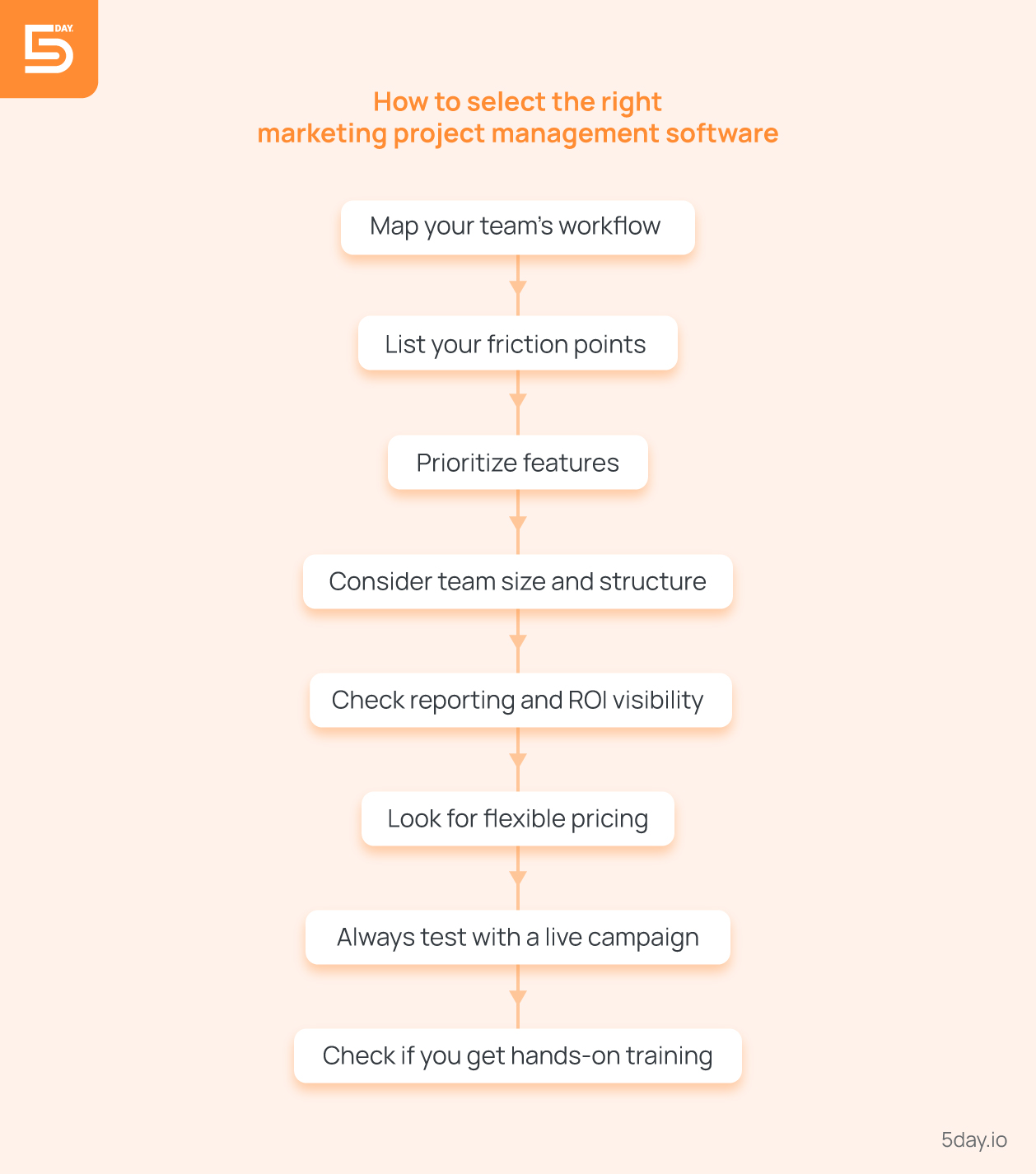
You’re up to date on what you need in a tool to take you from where you are to completely automate your workflows. Now is the best part. Evaluating tools correctly, so you land the best marketing project management software.
Step 1: Map your team’s workflow
Sit down and map out how your team works, right from the time the lead converts to when you offboard a client after a successful project. What goes on with every type of project and task? Don’t dwell too much on what should happen. Just map what is happening. If you want to improve the current process, you’re on, this is the perfect time.
Once you’re done with As-is, you move on to the ideal process your agency (considering your agency size, industries you cater to, and projects you work on) needs to have.
Step 2: List your friction points
When you do this exercise, you’ll arrive at where every team member and team need to be supported, and the gaps they are facing with the current system at hand. What qualms do you have to handle frequently? Note them down:
- We lose track of revisions.
- Nobody knows what is due.
- We spend hours in status meetings.
- The client keeps emailing instead of using the tool.
- We’re always over budget and don’t realize until it’s too late.
- No one knows what the designers are working on.
- Marketing and sales aren’t on the same page.
Write them all down, from minor annoyances to major blockers. This list will be your buying compass, because the right tool should directly solve these problems.
Step 3: Prioritize features
Take your workflow and friction list from Steps 1 and 2 and identify the must-haves vs nice-to-haves. Which ones do you need customized to your agency’s specific workflows, and which ones can you take as-is? Which ones do you need to reduce your manual workload immediately, and which ones can you bring in a phased manner? Make note of all of this.
Josh Nelson, mentor and coach for agency founders says, “When you’re scaling a digital marketing agency, one of the most critical steps you need to take is to choose a project management software. Choosing the wrong one with features that don’t suit you leads to many problems down the road, like having to rebuild your system, wasting time and money, and retraining your team every time.”
Step 4: Consider team size and structure
A freelancer, a 6-person in-house team, and a 40-person agency all need very different things. If you’re small, you need speed, simplicity, and easy onboarding. If you’re mid-size, you need accountability, templates, and better visibility. If you’re large, you need role-based permissions, budget tracking, and scalable workflows.
Also consider how your team is structured. Do you have dedicated account managers? Do creatives and strategists work in pods or float across projects? Is your leadership hands-on or dashboard-driven? Choose a tool that adapts to your structure.
Step 5: Check reporting and ROI visibility
You need a tool that gives you insight into outcomes. Check if you see how much time is being spent per client, if you can track budget vs actuals in real time, visualize KPIs per campaign or channel, and track capacity.
If a tool only shows you “what’s done” — but not how efficiently, by whom, or at what cost, it’s not helping your marketing team become smarter or more profitable.
Step 6: Look for flexible pricing
You don’t want to get locked into a tool that charges features you don’t need, bills you for inactive users, or has complicated enterprise-only pricing. Instead, when you’re browsing project management software for marketing teams, look up their pricing and check for scalable pricing: per seat, per client, or per feature. Also check for startup-friendly plans or nonprofit discounts if applicable, and transparent upgrade paths — so you know what it’ll cost as your team grows.
Step 7: Always test with a live campaign
Use the tool during the free trial with your real team. Set up one active campaign, assign tasks, upload files, request approval, tag teammates, and track status.
This test will surface all the truths:
- Is it easy to onboard new members?
- Are creatives comfortable using it?
- Can your client give feedback without confusion?
- Does the calendar view help or confuse?
- How fast do things move compared to your old setup?
Nothing reveals fit like doing the work inside the tool itself.
Step 8: Check if you get good hands-on training
Even the best tool is useless if no one knows how to use it.
Check:
- Do they offer live onboarding for your team?
- Is there chat/email support that actually replies fast?
- Are there helpful video tutorials, documentation, or community forums?
- Will someone walk you through a setup tailored to your workflow, or is it DIY?
For large teams or agencies, also look for dedicated account managers or custom onboarding packages. Adoption determines ROI, and adoption only happens when your team feels supported, not overwhelmed.
How 5day.io supports marketing teams with all the essential features
Great work alone isn’t enough. It must be done on time, needs sign-off from all stakeholders involved, and ROI proved time and time again. That’s where 5day.io walks in — not just as another project management software, but as a purpose-built system that understands how marketing work really flows.
Here’s how 5day.io can really make a difference to your marketing team:
- Plan campaigns across channels in one place (social, email, ads, events).
- Zoom out for quarterly planning or zoom in for daily execution
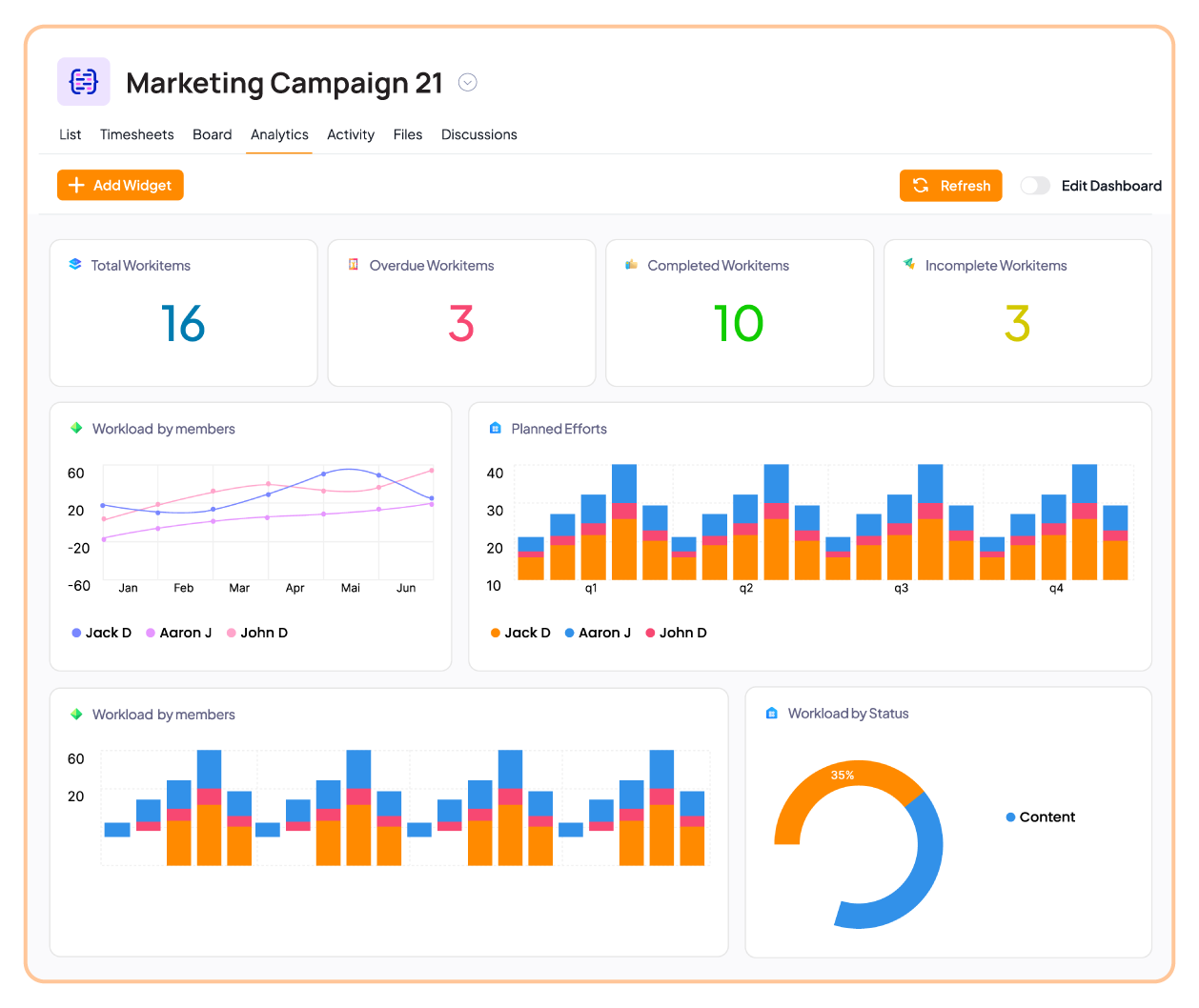
Visually manage content pipelines without switching tools
Attach design files, copy drafts, ad mockups, and videos directly to tasks.
@Mention teammates directly in tasks or subtasks
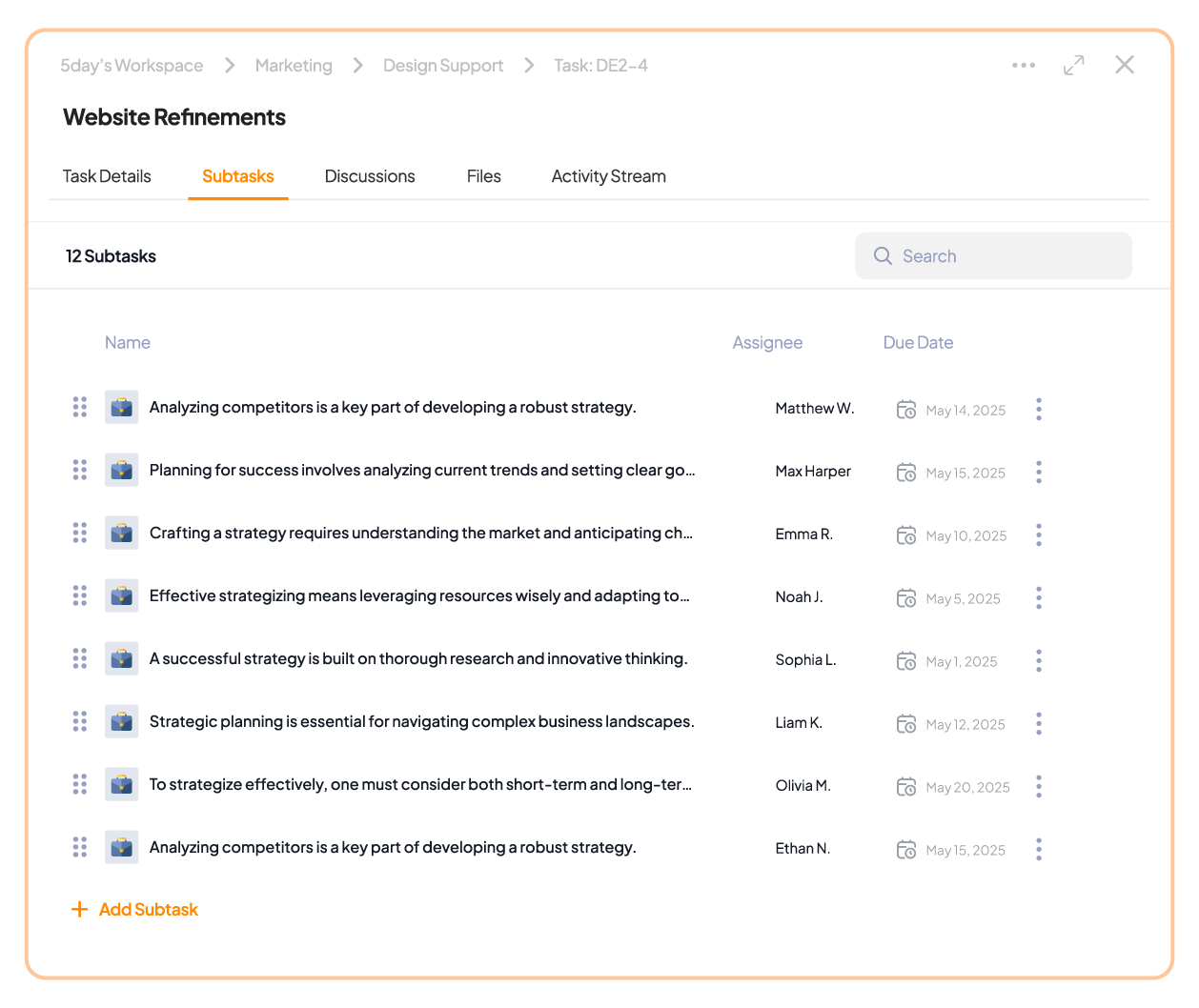
Tag clients or reviewers without them needing to join another chat tool
Allow clients to only view only what you want them to see, and drop feedback on files or content blocks
Automate recurring tasks (e.g., “Weekly Newsletter Draft – Due Monday”). Create rules like “If social copy is approved, notify designer for visual.”
Create role-specific dashboards: for clients, ops, design, or strategy leads. Visualize budget burn in real time.
Track how many hours are spent vs planned. Identify which roles are overworked or underutilized
Connect 5day.io to Google Drive and OneDrive and manage files easily.
The 5day.io mobile app keeps you updated, in control, and productive. Push notifications keep you looped in on deadlines and feedback.
Track time per task, per team member — so you spot scope creep early.
Set task links to connect two related tasks, so creatives can work on them one after another.
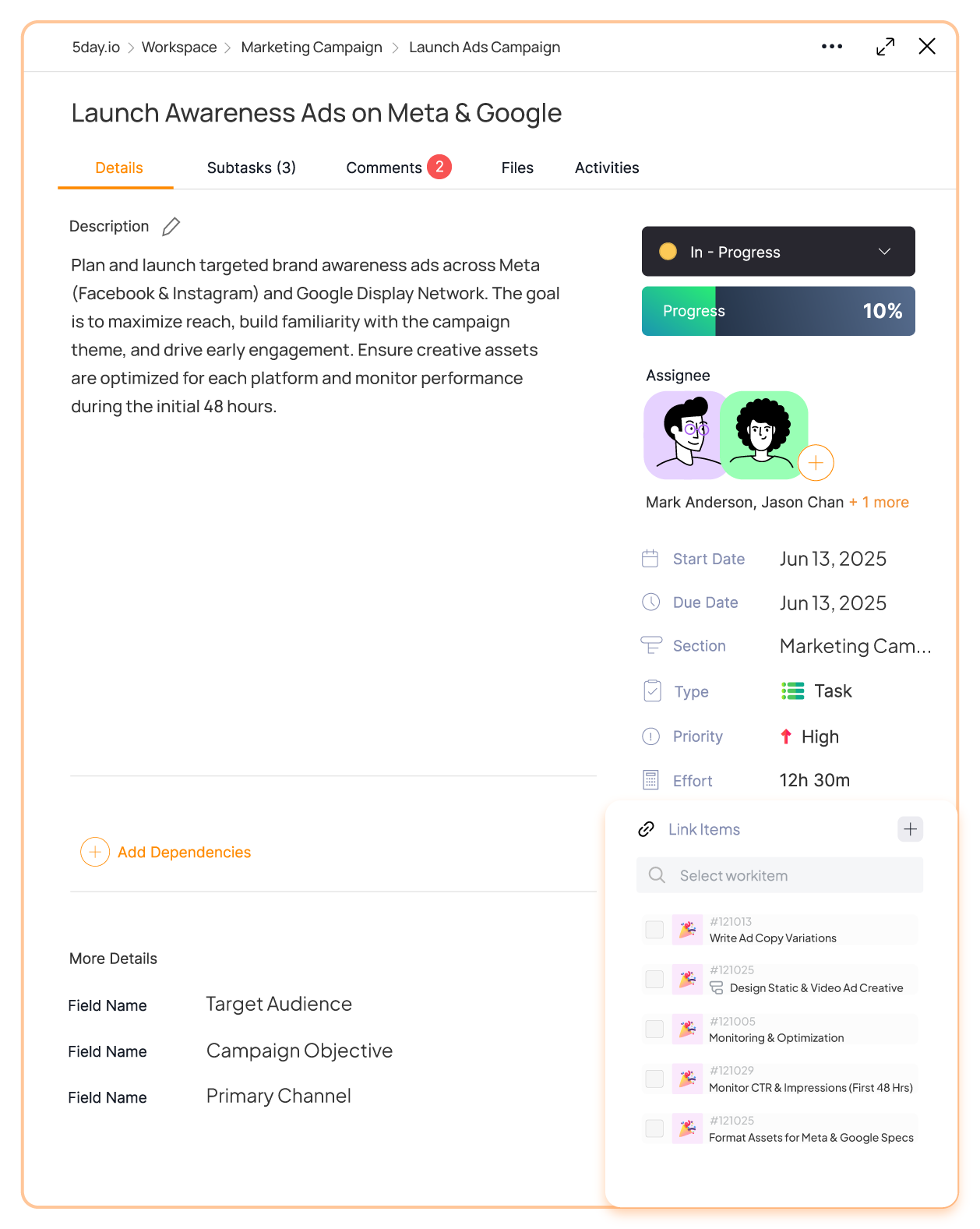
Wrapping up
Generic project management tools often fall short because they weren’t built for the rhythm and complexity of marketing work. That’s why choosing the right marketing and creative project management software is more than a tech decision. It brings clarity to your campaigns, keeps your team aligned, reduces rework, shortens feedback cycles, and gives leadership the insights they need to grow accounts and protect margins.
Sign up for 5day.io’s 3-month free trial today and experience this change first-hand.
